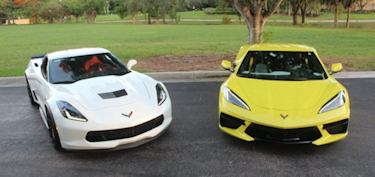C7 & C8 Side-By-Side Comparison
Although they are both low-slung high-performance coupes, the designs of the C8 and C7 differ in many ways. There are two major reasons for this. One is that the C8 is the first mid-engine Chevy Corvette. The mechanical parts are of course hidden from view, but the very different location of the engine compared with the C7 has an inevitable influence on the exterior design.
The other is that auto design in general evolved in the six years between the introductions of the two models. As we will see, the Chevy Corvette C8 has styling elements which might have looked fussy back in 2014, but are more familiar today.

This is immediately obvious even from a restricted, road-level view of the two Corvettes' front ends, as shown above. The C7 has a single air intake of an almost quadrilateral shape, though in fact a tweak at each lower corner means that it is in fact six-sided. By comparison, the C8 has three lower grilles covering a much larger area. The largest of these, in the center of the fascia, is separated from those on each side by diagonal lines which move inward and upward from the bottom to the top.
The C7's hood has a pronounced bulge in it to clear the top of the V8 engine, translating to very pronounced levels of surface development. This is not necessary - and was not retained even for styling purposes - on the C8, whose engine resides several feet behind its location in the C7.
The driving lights on the C7 predominantly run along the lower edge of the headlight units, but kick up as they head toward the sides of the car, creating a hockey stick pattern. Meanwhile, each headlight on the C8 has two sets of driving lights / daytime running lights, one running along the top inner edge and another that takes a much shorter and almost vertical route on the outer edge. Also notable is the contrast in size of the Corvette logos on the two cars - large on the C7, considerably smaller on the C8.
From a side view, the changes that Chevrolet was obliged to make to the Chevy Corvette design due to the different mechanical layout become very obvious. In the C7, the passengers sit very far back, due to the position of the engine up front and nothing of comparable size behind it. The car, therefore, has a very long hood and "cab-rearward" proportions in comparison with the C8, which has what was once called a 'cab forward' look because in this case the engine effectively pushes the passenger compartment toward the front. Whereas the two C7 occupants sit almost near the rear wheels, their counterparts in the C8 sit roughly in the middle of the car.
For obvious reasons, the air intakes/outlets are entirely different between the two models. The C7 has an air outlet / extractor behind the front wheels, from which heat and turbulent under hood air is expelled from. It is followed by a small intake behind the doors, just ahead of the rear wheels. There is no corresponding front outlet in the C8, because it doesn't need one, but a very large intake that sends air into the engine compartment can be seen at the rear.
In each case, the roofline is at its highest above the passengers' heads. Since the passengers in the C8 sit so much further forward, this gives it an advantage, since the roof has far more space to complete its slow descent to the rear of the car, and leads into a flatter panel behind the engine compartment. It is also very likely that the C8, therefore, has an aerodynamic advantage over the C7, at least at the rear.
Source: David Finlay - GM Authority
Posted 7/9/21